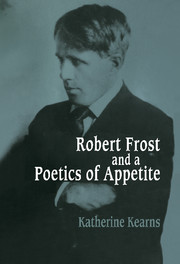Book contents
- Frontmatter
- Contents
- Acknowledgments
- Introduction: The Serpent's Tail
- 1 Irony: Teiresias's Gaze
- 2 Irony II: This Is Not a Pipe
- 3 Women: Dryads, Witches, and Hill Wives
- 4 Eros: The Mischief Maker
- 5 Prosody: White Noise
- 6 Lyricism: At the Back of the North Wind
- Conclusion: Out Far and in Deep
- Notes
- Index
- CAMBRIDGE STUDIES IN AMERICAN LITERATURE AND CULTURE
5 - Prosody: White Noise
Published online by Cambridge University Press: 19 March 2010
- Frontmatter
- Contents
- Acknowledgments
- Introduction: The Serpent's Tail
- 1 Irony: Teiresias's Gaze
- 2 Irony II: This Is Not a Pipe
- 3 Women: Dryads, Witches, and Hill Wives
- 4 Eros: The Mischief Maker
- 5 Prosody: White Noise
- 6 Lyricism: At the Back of the North Wind
- Conclusion: Out Far and in Deep
- Notes
- Index
- CAMBRIDGE STUDIES IN AMERICAN LITERATURE AND CULTURE
Summary
No matter how humorous I am I am sad. I am a jester about sorrow.
Robert Frost, Family Letters 210Here I lie mournful with desire,
feeble in bitterness of the pain gods inflicted upon me,
stuck through the bones with love.
Archílochus of ParosIn “The Witch of Coos” only the woman/wife/lover/mother/witch can hear the bones’ chalky progress upstairs, while her husband never “seem[s] to hear them,” even as he rousts himself reluctantly from bed to help shut the skeleton in the attic. He only humors his wife's hysteria, but just as Frost's own mother funded him with magical stories, the “witch” has, over forty years’ time, given her son an intimate knowledge of the night her buried lover wandered upward. The poem is antiphonal, with mother and son speaking parts labeled with their names. The son has appropriated his mother's tale and tells it with great relish even though he admits that, when it happened, “I was a baby: I don't know where I was.” Of the skeleton, he says, “It left the cellar forty years ago / And carried itself like a pile of dishes / Up one flight from the cellar to the kitchen….” His metaphor, domestic and feminine as it is, is probably originally his mother's, although it also represents his own feminized, maternally oriented vision. It supports, too, as do the mother's images of the skeleton as “like a chandelier” and “a chalk-pile,” the crucial interdependence of visual and aural components, a macabre sound of sense.
- Type
- Chapter
- Information
- Robert Frost and a Poetics of Appetite , pp. 134 - 156Publisher: Cambridge University PressPrint publication year: 1994

